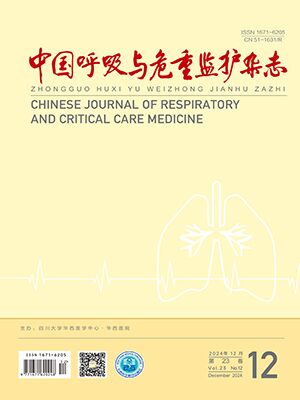| 1. |
Bersten AD, Edibam C, Hunt T, et al. Incidence and mortality of acute lung injury and the acute respiratory distress syndrome in three Australian States. Am J Respir Crit Care Med, 2002, 165(4): 443-448.
|
| 2. |
Li S, Zhao D, Cui J, et al. Prevalence, potential risk factors and mortality rates of acute respiratory distress syndrome in Chinese patients with sepsis. J Int Med Res, 2020, 48(2): 1219695211.
|
| 3. |
Bellani G, Laffey JG, Pham T, et al. Epidemiology, patterns of care, and mortality for patients with acute respiratory distress syndrome in intensive care units in 50 countries. JAMA, 2016, 315(8): 788-800.
|
| 4. |
Huang X, Zhang R, Fan G, et al. Incidence and outcomes of acute respiratory distress syndrome in intensive care units of mainland China: a multicentre prospective longitudinal study. Crit Care, 2020, 24(1): 515.
|
| 5. |
张芮豪, 夏金根, 詹庆元. 脓毒症并发急性呼吸窘迫综合征的危险因素及预测评分研究进展. 解放军医学杂志, 2020, 45(12): 1309-1314.
|
| 6. |
赵晶晶, 周小妹, 姚莉. ICU重症肺炎患者进展为急性呼吸窘迫综合征的危险因素分析. 中国呼吸与危重监护杂志, 2018, 17(6): 561-564.
|
| 7. |
徐峰, 高海晋, 曹静, 等. 脓毒症患者预后相关因素及交互作用分析. 中国药物与临床, 2021, 21(10): 1668-1671.
|
| 8. |
Kamo T, Tasaka S, Suzuki T, et al. Prognostic values of the Berlin definition criteria, blood lactate level, and fibroproliferative changes on high-resolution computed tomography in ARDS patients. BMC Pulm Med, 2019, 19(1): 37.
|
| 9. |
Ranieri VM, Rubenfeld GD, Thompson BT, et al. Acute respiratory distress syndrome: the Berlin Definition. JAMA, 2012, 307(23): 2526-2533.
|
| 10. |
Singer M, Deutschman CS, Seymour CW, et al. The Third International Consensus Definitions for Sepsis and Septic Shock (Sepsis-3). JAMA, 2016, 315(8): 801-810.
|
| 11. |
Erickson SE, Martin GS, Davis JL, et al. Recent trends in acute lung injury mortality: 1996-2005. Crit Care Med, 2009, 37(5): 1574-1579.
|
| 12. |
Mcguinness G, Zhan C, Rosenberg N, et al. Increased incidence of barotrauma in patients with COVID-19 on invasive mechanical ventilation. Radiology, 2020, 297(2): E252-E262.
|
| 13. |
Gattinoni L, Marini JJ, Collino F, et al. The future of mechanical ventilation: lessons from the present and the past. Crit Care, 2017, 21(1): 183.
|
| 14. |
Radermacher P, Maggiore SM, Mercat A. Fifty years of research in ARDS. Gas exchange in acute respiratory distress syndrome. Am J Respir Crit Care Med, 2017, 196(8): 964-984.
|
| 15. |
Slutsky AS, Tremblay LN. Multiple system organ failure. Is mechanical ventilation a contributing factor?. Am J Respir Crit Care Med, 1998, 157(6 Pt 1): 1721-1725.
|
| 16. |
Balzer F, Menk M, Ziegler J, et al. Predictors of survival in critically ill patients with acute respiratory distress syndrome (ARDS): an observational study. BMC Anesthesiol, 2016, 16(1): 108.
|
| 17. |
Bone RC, Maunder R, Slotman G, et al. An early test of survival in patients with the adult respiratory distress syndrome. The PaO2/FiO2 ratio and its differential response to conventional therapy. Prostaglandin E1 Study Group. Chest, 1989, 96(4): 849-851.
|
| 18. |
卢善翃, 李俊辉, 欧阳莎, 等. 重症病毒性肺炎合并急性呼吸窘迫综合征的预后危险因素分析. 中国呼吸与危重监护杂志, 2014, 13(6): 560-564.
|
| 19. |
葛庆岗, 姚智渊, 王铁华, 等. 急性呼吸窘迫综合征发生及预后危险因素的多中心前瞻性队列研究. 中华危重病急救医学, 2014, 26(11): 773-779.
|
| 20. |
Vincent JL, Sakr Y, Sprung CL, et al. Sepsis in European intensive care units: results of the SOAP study. Crit Care Med, 2006, 34(2): 344-353.
|
| 21. |
Lai CC, Sung MI, Liu HH, et al. The ratio of partial pressure arterial oxygen and fraction of inspired oxygen 1 day after acute respiratory distress syndrome onset can predict the outcomes of involving patients. Medicine (Baltimore), 2016, 95(14): e3333.
|




